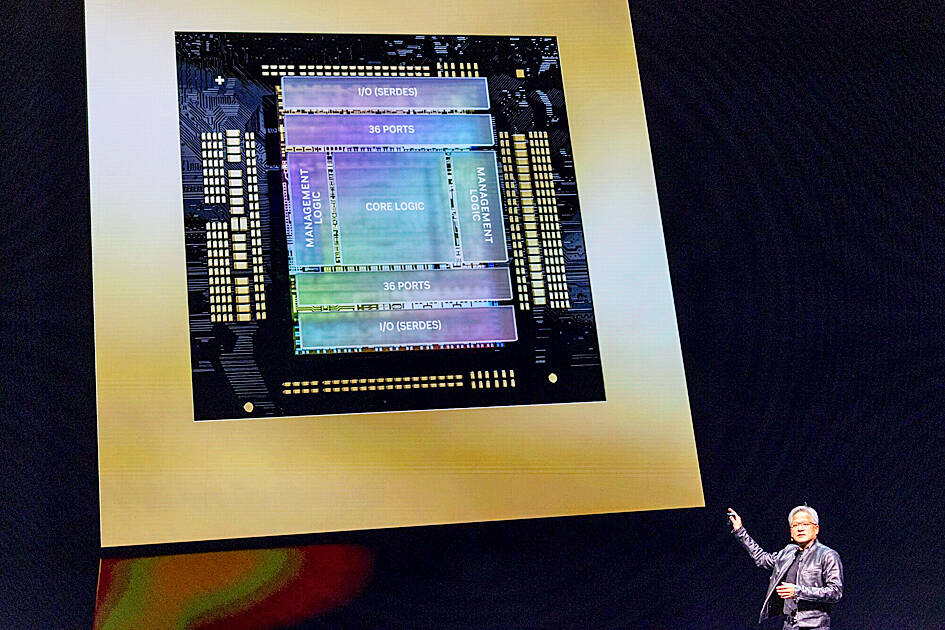Nvidia Corp CEO Jensen Huang (黃仁勳) unexpectedly unveiled the company’s next-generation graphics processing unit (GPU) architecture, codenamed Rubin, to be available in 2026, during a speech in Taipei on Sunday.
To go with the Rubin GPUs, Nvidia also plans to introduce a new-generation CPU called Vera in 2026, Huang said at the National Taiwan University Sports Center.
The company plans to launch an enhanced version of the upcoming Rubin GPUs, called Rubin Ultra, in 2027, he said.

Photo: Annabelle Chih, Bloomberg
The company’s Blackwell GPU architecture, announced in March to succeed the Hopper framework, are to hit the market this year followed by the Blackwell Ultra units next year, he said.
Rubin GPUs are likely to be built using Taiwan Semiconductor Manufacturing Co’s (TSMC, 台積電) most advanced 3-nanometer process technology, an upgrade from the 4-nanometer process technology used to produce the Blackwell B100 accelerators, TF International Securities Group Co (天風國際證券) analyst Kuo Ming-chi (郭明錤) wrote on X.
Nvidia would likely also adopt TSMC’s chip-on-wafer-on-substrate advanced packaging technology for the new Rubin GPUs, as it would with the B100s, Kuo said.
The Rubin GPUs would likely enter mass production in the fourth quarter of next year, he said.
“Our company is in a one-year rhythm,” Huang said. “On a one-year rhythm and we push everything, the technology limits whatever TSMC process technology pushes it to the absolute limits. Whoever’s packing technology pushes it to absolute limits. Whatever memory technology pushes it to absolute limits.”
During his speech, Huang also talked about digital humans, artificial intelligence (AI) PCs, robotics and industrial automation, and expected a larger swath of companies and government agencies to embrace AI.
In the future, "almost every interaction you have with the Internet or with a computer will likely have a generative AI running in the cloud somewhere," he said.
But as the amount of data that needs to be processed grows exponentially in the AI era, traditional computing methods cannot keep up and it’s only through Nvidia’s style of accelerated computing that firms can cut back the costs, Huang said.
He therefore outlined how some top tech companies such as Taiwan's Foxconn Technology Group (富士康科技集團) — the world's largest contract electronics manufacturer — and German industrial giant Siemens AG are using Nvidia's platforms to develop AI-powered autonomous robots.
In addition, he announced that Asustek Computer Inc (華碩), Gigabyte Technology Co (技嘉), Ingrasys Inc (鴻佰), Inventec Corp (英業達), Wiwynn Corp (緯穎), Pegatron Corp (和碩), Cloud Technology Inc (雲達) and Super Micro Computer Inc would deliver cloud, on-site, embedded and edge AI systems using Nvidia GPUs and networking chips.
“Taiwan is the home of our [Nvidia’s] treasured partners. This is, in fact, where everything Nvidia does begins. Our partners and ourselves take it to the world. Taiwan and our partnership has created the world’s AI infrastructure,” Huang said.
Additional reporting by agencies

JITTERS: Nexperia has a 20 percent market share for chips powering simpler features such as window controls, and changing supply chains could take years European carmakers are looking into ways to scratch components made with parts from China, spooked by deepening geopolitical spats playing out through chipmaker Nexperia BV and Beijing’s export controls on rare earths. To protect operations from trade ructions, several automakers are pushing major suppliers to find permanent alternatives to Chinese semiconductors, people familiar with the matter said. The industry is considering broader changes to its supply chain to adapt to shifting geopolitics, Europe’s main suppliers lobby CLEPA head Matthias Zink said. “We had some indications already — questions like: ‘How can you supply me without this dependency on China?’” Zink, who also

The number of Taiwanese working in the US rose to a record high of 137,000 last year, driven largely by Taiwan Semiconductor Manufacturing Co’s (TSMC, 台積電) rapid overseas expansion, according to government data released yesterday. A total of 666,000 Taiwanese nationals were employed abroad last year, an increase of 45,000 from 2023 and the highest level since the COVID-19 pandemic, data from the Directorate-General of Budget, Accounting and Statistics (DGBAS) showed. Overseas employment had steadily increased between 2009 and 2019, peaking at 739,000, before plunging to 319,000 in 2021 amid US-China trade tensions, global supply chain shifts, reshoring by Taiwanese companies and

Taiwan Semiconductor Manufacturing Co (TSMC, 台積電) received about NT$147 billion (US$4.71 billion) in subsidies from the US, Japanese, German and Chinese governments over the past two years for its global expansion. Financial data compiled by the world’s largest contract chipmaker showed the company secured NT$4.77 billion in subsidies from the governments in the third quarter, bringing the total for the first three quarters of the year to about NT$71.9 billion. Along with the NT$75.16 billion in financial aid TSMC received last year, the chipmaker obtained NT$147 billion in subsidies in almost two years, the data showed. The subsidies received by its subsidiaries —

OUTLOOK: Pat Gelsinger said he did not expect the heavy AI infrastructure investments by the major cloud service providers to cause an AI bubble to burst soon Building a resilient energy supply chain is crucial for Taiwan to develop artificial intelligence (AI) technology and grow its economy, former Intel Corp chief executive officer Pat Gelsinger said yesterday. Gelsinger, now a general partner at the US venture capital firm Playground Global LLC, was asked at a news conference in Taipei about his views on Taiwan’s hardware development and growing concern over an AI bubble. “Today, the greatest issue in Taiwan isn’t even in the software or in architecture. It is energy,” Gelsinger said. “You are not in the position to have a resilient energy supply chain, and that,